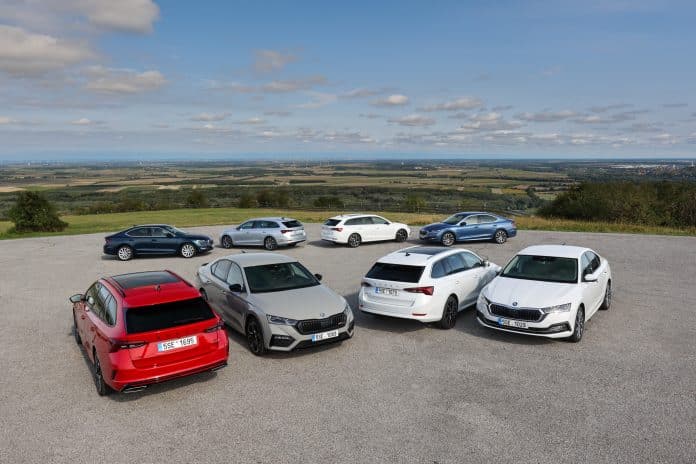The launch of the fourth-generation ŠKODA Octavia sees plenty of new assistance systems and advanced infotainment. Available with an efficient petrol or diesel engine, or one of two alternative powertrains in the UK, the new-generation Octavia is also significantly more sustainable. The Octavia e-TEC is the first ever ŠKODA to feature mild hybrid technology. The Octavia iV and the sporty Octavia vRS iV are modern plug-in hybrids. Thanks to the two sustainable powertrain variants, the new Octavia’s CO2 emissions have been considerably reduced.
The ŠKODA Octavia is available as a hatch and estate; three sporty vRS versions have also been added to the line-up. Fitted with a choice of front- or all-wheel drive and manual or automatic DSG transmissions.
There are numerous innovative safety and assistance systems including, Park Assist with Area View whose four cameras create a 360-degree image of the vehicle’s immediate surroundings, Adaptive Lane Assist, which is able to identify roadworks as well as conventional road markings, and the Local Traffic Warning function that automatically warns of traffic hold-ups in the car’s vicinity, such as the end of a traffic jam. For the first time, ŠKODA is also offering the new head-up display which projects information such as the car’s speed, navigation instructions, detected traffic signs and activated driver assistance systems directly onto the windscreen. There is also a choice of three infotainment systems from the latest generation with screens measuring between 8.25 and 10 inches. Thanks to a built-in eSIM, the vehicle is always online – thus enabling the use of new ŠKODA Connect online services.
The letter combinations – iV and e-TEC – make reference to the wide range of new alternative powertrain variants available for the new Octavia. Both the Octavia iV and Octavia vRS iV feature plug-in hybrid drive and provide an all-electric and therefore zero-emission range of up to 60 km in the WLTP cycle. The e-TEC designation is new to ŠKODA and is reserved for cars equipped with mild hybrid technology – another first for the brand. The TSI petrol engines in these models are electrified by a 48-V belt-driven starter motor and a 48-V lithium-ion battery.
Driving Mode Select is a familiar feature found in other ŠKODAs. In the Octavia iV and Octavia vRS iV, Eco, Normal, Sport and Individual driving modes can be chosen – as well as a Comfort option if the car is fitted with Dynamic Chassis Control (DCC). These allow settings for the steering or the engine and transmission control, for example, to be adjusted. The driver can also switch between E-mode and Hybrid mode on the central Driving Mode Select display. Energy recovery during braking helps to effectively increase the range of an electrified vehicle, as the battery is charged using recuperation whilst the car is in motion.
In terms of exterior styling, the Octavia vRS iV’s sporty credentials are evident, with air curtains, a diffuser on the vRS-specific front and rear apron, aeroflaps, and window frames that all come in sporty black. The hatch is also fitted with a black vRS rear spoiler; in the estate, the roof spoiler matches the body colour. The vRS iVs are equipped with LED head lights and black 18‑inch alloy wheels as standard; 19-inch wheels are available on request. The brake callipers come in an vRS-typical red finish to catch the eye. The interior of the Octavia vRS iV is predominantly black. The three-spoke leather multifunction sports steering wheel bears a vRS logo and features paddles for operating the DSG. Providing a dynamic visual touch, the sports seats for the driver and front passenger as well as the rear seats bear the vRS emblem and coloured decorative stitching in red or silver-grey, which can also be found on the leather steering wheel, the armrests and the Alcantara®-covered dashboard. Decorative strips in an vRS look and pedals with an aluminium design round off the interior’s sporty impression.
The two Octavia e-TECs are the first ŠKODA production cars ever to come with mild hybrid technology. The main purpose of the mild hybrid technology is to supply the engine with an electrical boost of up to 50 Nm if required and enable the e-TECs to coast with the engine completely disconnected. This reduces fuel consumption by up to 0.4 l per 100 km and lowers CO2 emissions. Furthermore, the engine can be started more quickly, more smoothly and with less vibration. The Octavias featuring mild hybrid technology are identifiable by an e-TEC badge on their tailgate.
There is a choice of three different infotainment systems from Volkswagen Group’s latest-generation Modular Infotainment Matrix. Even the entry-level Swing radio, featuring an 8.25-inch customisable touchscreen, provides DAB reception and boasts wireless SmartLink technology for integrating smartphones as well as Android Auto, Apple CarPlay and MirrorLink™.
Many of the assistance systems in the new Octavia are making their ŠKODA debut, while others have been further improved. Collision Avoidance Assist supports controlled evasive manoeuvres by actively amplifying the steering moment, thus helping to prevent an imminent collision with a pedestrian, cyclist or other vehicle. When turning left at junctions, Turn Assist warns the driver of oncoming traffic in advance and can even stop the car automatically. Exit Warning lets the occupants know if another vehicle or a cyclist is approaching from behind when opening the car door. The new Local Traffic Warning function automatically alerts the driver of traffic disruptions in the car’s vicinity, such as the end of a traffic jam. When parking or manoeuvring, Area View displays the OCTAVIA’s immediate surroundings in a 360-degree image generated by four cameras. Up to a distance of 70 m, Side Assist warns the driver of vehicles approaching from behind or when they are in the blind spot. In the city, Front Assist including Predictive Pedestrian and Cyclist Protection indicates the potential for a collision visually, acoustically and through gentle braking, and performs an emergency stop when necessary.
Predictive Cruise Control uses images from the camera in the windscreen and data from the navigation system to automatically adjust the speed to suit the road ahead. In addition to the improved Traffic Sign Recognition, Adaptive Lane Assist, which also detects roadworks, Traffic Jam Assist and Emergency Assist, it is part of the comprehensive Travel Assist function, which includes Hands-on Detect too. Using Hands-on Detect, the system checks whether the driver is touching the steering wheel every 15 seconds or whether they may no longer have control of the vehicle due to a potential medical emergency. In this case, Emergency Assist activates the hazard lights and brings the car to a stop in its current lane.




